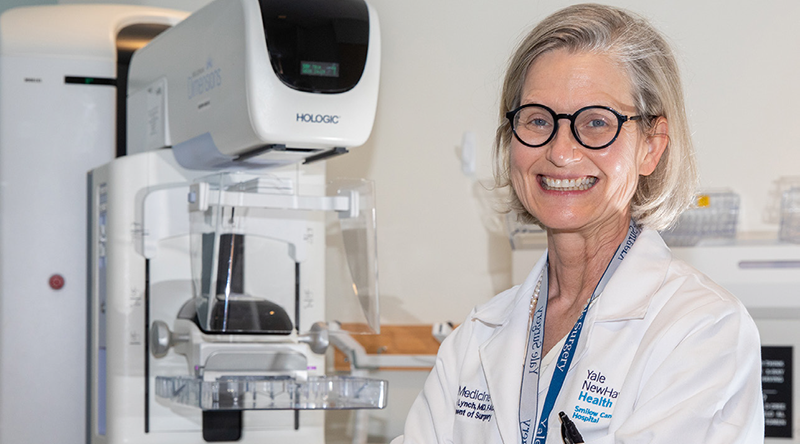
Melanie Lynch, MD, medical director of the Norma Pfriem Breast Center and director of breast surgery at Smilow Cancer Hospital’s Care Centers in Bridgeport, Fairfield and Trumbull, explains how new recommendations focused on risk rather than age are helping to detect breast cancer sooner in high-risk patients.
Breast cancer screening plans help save more lives
It’s no secret that breast cancer screening saves lives. But screening plans based on risk rather than age are now helping to save even more.
In women, breast cancer is the most common cancer and the second-most common cause of cancer death, but mammography has played a critical role in detecting it in its earliest stages when it is most treatable. “Breast cancer mortality has decreased by 30 percent, directly attributable to screening mammography – it’s really so important,” said Melanie Lynch, MD, medical director of the Norma Pfriem Breast Center and director of breast surgery at Smilow Cancer Hospital’s Care Centers in Bridgeport, Fairfield and Trumbull.
“Today, we’re moving from the era of age-based screening recommendations to the era of risk-based recommendations,” Dr. Lynch said. “What this really reflects is an understanding that breast cancer risk is not the same for every woman, so the screening plan should not be the same for every woman.”
When should a woman get screened?
“In general, women do not need to screen for breast cancer until after the age of 40, unless they fall into a high-risk group,” Dr. Lynch explained. “The most accepted guidelines are from the American Cancer Society that say women should begin screening for breast cancer at the age of 45 and stop screening within 10 years before the end of life – generally, age 70 to 75.”
“The American College of Radiology really led the way with their recommendations for risk-based screening,” Dr. Lynch said. “Risk-based screening recommendations endorse that every woman at the age of 30 should have a breast cancer risk assessment and, at that time, develop a plan for screening.”
Patients in the high-risk group include those with a genetic predisposition, a significant family history of cancer, or individual risk factors for breast cancer.
Screening technologies advance
The standard of care for routine breast cancer screening has evolved in recent years to include tomosynthesis, also known as 3D mammography, which is up to 30 percent more effective at detecting abnormalities, Dr. Lynch said. Unlike a traditional mammogram, a 3D mammogram takes multiple images of the breasts in thin “slices,” providing a clearer view of the breast tissue.
“Women who fall into a high-risk group, where their risk of breast cancer is greater than 20 percent lifetime risk, is the group who should be screened with both 3D mammogram and breast MRI,” Dr. Lynch said.
The MRI (magnetic resonance imaging) is an improvement in sensitivity for screening because of the intravenous (I.V.) contrast received before the scan. The contrast shows blood flow in and out of tissue and can reveal areas of cancer that might otherwise be missed.
High-risk screening in practice
Dr. Lynch recalled how risk-based screening helped a 35-year-old patient whose mother had died of breast cancer in her late 40s. “Her primary care doctor had recognized her increased risk for breast cancer and sent her to our program,” Dr. Lynch said. “We did a complete family history, referred her for genetic counseling and testing, and set her up for breast MRI for baseline screening. Her genetic testing identified a mutation in a breast cancer-related gene.”
Although results of her mammogram and follow-up ultrasound were normal, the MRI told a different story.
“She went to surgery, had her breast cancer treated and is doing fine,” Dr. Lynch said. “With risk-based screening, we were able to find a cancer that otherwise might not have shown up until a few years later, possibly at an advanced stage.”
Learn more about services at the Norma Pfriem Breast Center.

